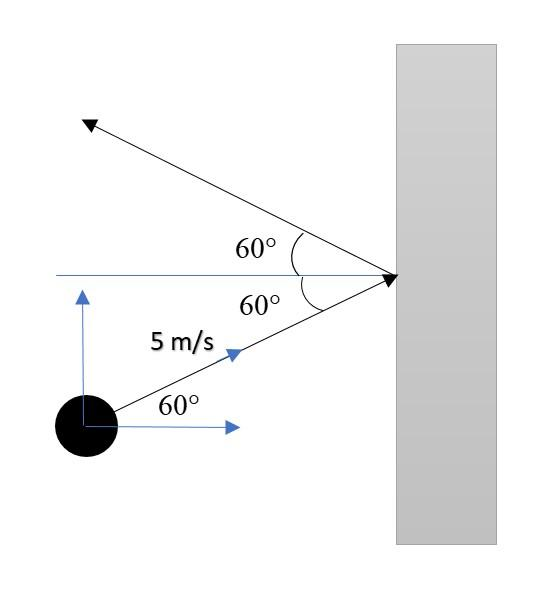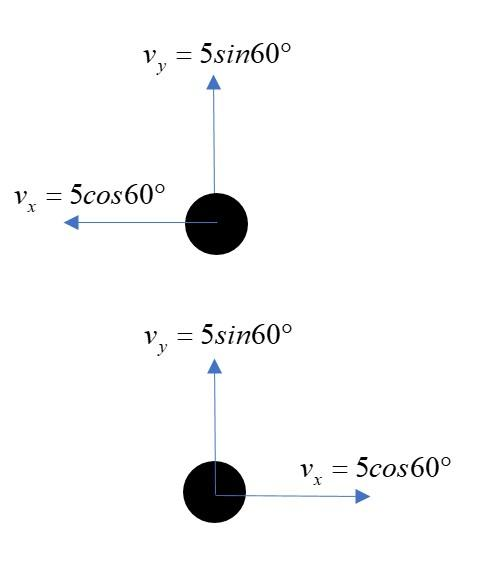
A mass of 100 g strikes the wall with speed 5 m/s at an angle as shown in the figure and it rebounds with the same speed. If the contact time is $2\times 10^{-3}\ sec$, what is the force applied on the mass by the wall?

$\text{A.}\quad 250\sqrt3\ N$ to the right.
$\text{B.}\quad 250\ N$ to the right.
$\text{C.}\quad 250\sqrt3\ N$ to the left.
$\text{D.}\quad 250\ N$ to the left.

Answer
574.5k+ views
Hint: According to Newton’s second law of motion, force on a body is equal to the rate of change of its momentum. In other words, if there will be a change in momentum of the body, then there must be a force acting on it.
Formula used:
$\vec F = \dfrac{d{\vec P}}{dt}$
Complete step-by-step answer:
In the statement, it is given that the speed of the body after striking the wall is the same as before. The best way to tackle these types of questions is that we can make the free body diagram of the body both before and after the collision and observe the change in velocity in different directions.

As shown in the above figure, the velocity of the ball in upward direction (Parallel to the wall) is $v_y = 5sin 60^\circ = 5\times \dfrac{\sqrt 3}{2} m/s$. This velocity is constant before and after collision. Thus the force in net direction must be zero, otherwise there must be a change in this velocity (either in magnitude or direction or both).
Now, velocity in x-direction (towards the wall) is $5cos60^\circ = 5\times \dfrac 12 = \dfrac 52 m/s$
But after striking the wall, it changes to $-5cos60^\circ = -\dfrac52 m/s$
Thus change in momentum in x-direction = $m(\dfrac 52 - (-\dfrac 52)) = m\times 5 = 0.1 \times 5 = 0.5 N-s$.
Or $d\vec P = 0.5 Ns$
Also, the time of contact = $dt = 2\times 10^{-3}s$
Hence using:
$\vec F = \dfrac{d{\vec P}}{dt}$
We get $\vec F = \dfrac{0.5}{2\times 10^{-3}} = 250 N$
Now, for the direction, we can say that the force must be applied on the mass towards the left (perpendicular to the wall).
So, the correct answer is “Option D”.
Note: There is one more concept, which is basically the extension of Newton’s second law, which is called the Impulse momentum theorem. We can apply this theorem also to find the force. This is applicable when there is a huge force on a body which acts on a body for a very short period of time.
Formula used:
$\vec F = \dfrac{d{\vec P}}{dt}$
Complete step-by-step answer:
In the statement, it is given that the speed of the body after striking the wall is the same as before. The best way to tackle these types of questions is that we can make the free body diagram of the body both before and after the collision and observe the change in velocity in different directions.

As shown in the above figure, the velocity of the ball in upward direction (Parallel to the wall) is $v_y = 5sin 60^\circ = 5\times \dfrac{\sqrt 3}{2} m/s$. This velocity is constant before and after collision. Thus the force in net direction must be zero, otherwise there must be a change in this velocity (either in magnitude or direction or both).
Now, velocity in x-direction (towards the wall) is $5cos60^\circ = 5\times \dfrac 12 = \dfrac 52 m/s$
But after striking the wall, it changes to $-5cos60^\circ = -\dfrac52 m/s$
Thus change in momentum in x-direction = $m(\dfrac 52 - (-\dfrac 52)) = m\times 5 = 0.1 \times 5 = 0.5 N-s$.
Or $d\vec P = 0.5 Ns$
Also, the time of contact = $dt = 2\times 10^{-3}s$
Hence using:
$\vec F = \dfrac{d{\vec P}}{dt}$
We get $\vec F = \dfrac{0.5}{2\times 10^{-3}} = 250 N$
Now, for the direction, we can say that the force must be applied on the mass towards the left (perpendicular to the wall).
So, the correct answer is “Option D”.
Note: There is one more concept, which is basically the extension of Newton’s second law, which is called the Impulse momentum theorem. We can apply this theorem also to find the force. This is applicable when there is a huge force on a body which acts on a body for a very short period of time.
Recently Updated Pages
Master Class 11 Economics: Engaging Questions & Answers for Success

Master Class 11 English: Engaging Questions & Answers for Success

Master Class 11 Social Science: Engaging Questions & Answers for Success

Master Class 11 Biology: Engaging Questions & Answers for Success

Class 11 Question and Answer - Your Ultimate Solutions Guide

Master Class 11 Business Studies: Engaging Questions & Answers for Success

Trending doubts
What is meant by exothermic and endothermic reactions class 11 chemistry CBSE

10 examples of friction in our daily life

One Metric ton is equal to kg A 10000 B 1000 C 100 class 11 physics CBSE

Difference Between Prokaryotic Cells and Eukaryotic Cells

What are Quantum numbers Explain the quantum number class 11 chemistry CBSE

1 Quintal is equal to a 110 kg b 10 kg c 100kg d 1000 class 11 physics CBSE




